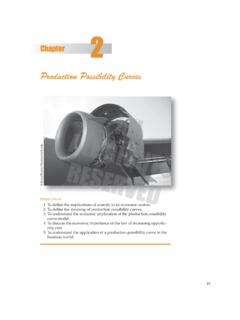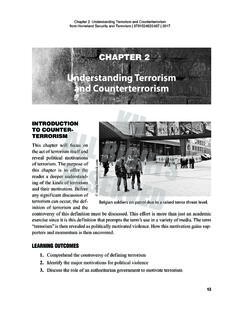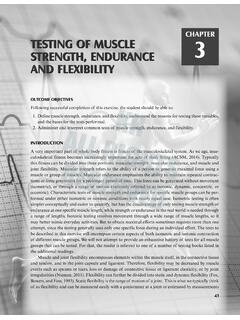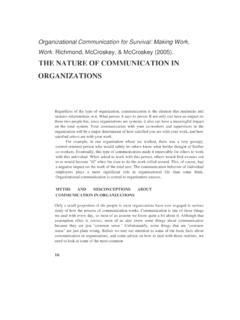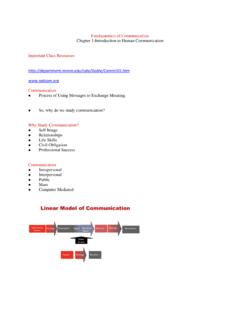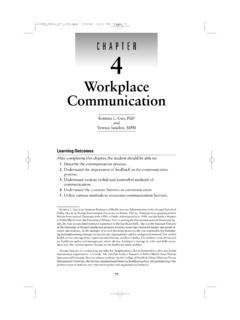Transcription of PHYSICAL APPEARANCE: THE BODY AS NONVERBAL …
1 Chapter fiveArtifacts Jewelry Eyeglasses MakeupModifying the body Piercings Tattoos Cosmetic Procedures The Televisual Makeover The Trouble with NormalizationUnderstanding PHYSICAL appearance : Applying the Reflexive Cycle of NONVERBAL communication DevelopmentSummarychapter outlinePhysical appearance as a NONVERBAL communication CodePhysical Attractiveness The Impact of PHYSICAL Attractiveness on Our CultureThe body body Type and Shape Weight Height and Status The Disabled body Skin Color body Smell HairClothing Functions of Clothing Expressions of Personality and Culture Dressing to Connect with OthersPHYSICAL appearance : THE body AS NONVERBAL COMMUNICATION151chapter five152chapter objectivesAfter studying this chapter, you should be able to 1. understand how people perceive PHYSICAL appearance as a form of NONVERBAL communication ; 2.
2 Improve your understanding of how PHYSICAL appearance impacts your perception of others, as well as your awareness and management of your own PHYSICAL appearance ; 3. explain the difference between attraction and attractiveness; 4. identify and describe Sheldon s body types, along with their corresponding psychological characteristics; 5. understand the role that clothing and artifacts play in NONVERBAL communication ; 6. define homophily; and 7. discuss various forms of body modification and how normalization affects our view of these forms of NONVERBAL Chris Christie of New Jersey has become a rising star in the Republican Party in recent years. During the run-up to the 2012 presidential election, Christie was considered a potential presidential, then vice-presidential candidate. However, some Republican donors voiced their concerns with the observation that people as heavy as Christie rarely live to an advanced age (Zernike & Santora, 2013).
3 Christie s weight began to be more of an issue than his political stanc-es. In the summer of 2013, Christie acknowledged that he had undergone lap-band surgery, a popular weight-loss procedure in which a silicone band is placed around the stomach to limit food intake. With Christie being at the forefront of potential Republican presidential candidates for 2016, many people believe he had the surgery to lose weight and thus increase his appeal to voters. Christie dismissed these assumptions, claiming that he had the surgery for long-term health reasons. In No-vember of 2014, Christie was overwhelmingly reelected as New Jersey s governor, and yet the media still drew attention to his weight. Time magazine s cover image right after Christie s decisive victory featured his profile all in black, emphasizing his double chin and girth, with a caption that read: The Elephant in the Room. Regardless of Christie s reasons for undergoing weight-loss surgery, the connection between phys-ical appearance and politics is especially relevant to our study of NONVERBAL communication .
4 Research shows that perceptions of political candidates PHYSICAL attractiveness play a role in how they are sup-ported and selected (Hart, Ottati, & Krumdick, 2011; Mandziuk, 2008; Schubert, Curran, & Strun-case studyAREA POLITICIAN S body AND HEALTH FAIR GAME? PHYSICAL appearance : The body as NONVERBAL Communication153garu, 2011). Unconsciously or not, we regularly judge peo-ple based on their PHYSICAL appearance . Our weight, height, clothing, piercings, tattoos, and countless other PHYSICAL aspects all communicate something about us. In Christie s case, his weight offends some people, even to the extent that they claim his girth makes him seem more belligerent or like more of a bully. Media pundits discuss whether his health can withstand the pressures of high office. However, some believe his weight is part of his appeal, in that he s a PHYSICAL and political force to be reckoned with.
5 So not all people take away the same impressions from PHYSICAL appearance ; the way we present our PHYSICAL bodies to others communicates different things to different you work through this chapter, reflect on instances in your life when you have judged (or been judged by) other people for appearance s sake. Oftentimes we fail to realize how much emphasis we place on our own PHYSICAL appear-ance, as well as others . Each section of this chapter will in-troduce you to different facets of PHYSICAL appearance . Use your personal experiences, as well as the research introduced in this chapter, to critique your perceptions of the power of PHYSICAL appearance in everyday life. Evelyn: Have you seen our new boss? Genie: No, what does he look like? Evelyn: He s really handsome and professional looking. Genie: Well, it s about time they hired someone who actually looks good. The other two executives didn t last around here because they just didn t have the image.
6 Evelyn: Exactly!What does the above conversation teach us? Evelyn and Genie reveal the importance of phys-ical appearance the way our bodies and overall appearance nonverbally communicate to others and impact our view of ourselves in everyday life. You may be thinking, How can PHYSICAL appearance , 2014, Shutterstock, Inc. New Jersey Governor Chris Christie is a captivating, if not controversial figure in national and state politics. Should his PHYSICAL appearance factor in to perceptions of his suitability as a leader?chapter five154or the way someone looks be communicative? That s not a bad question, which is why this chapter ad-dresses PHYSICAL appearance as a NONVERBAL communication you ever thought about how you avoid or are drawn to people who look a certain way? Think about how much time each day you spend grooming yourself. How does my hair look? Does this dress make me look fat? Will people be able to see sweat rings if I wear this shirt?
7 Should I use more hair spray? Should I tuck my shirt in or leave it out? Am I wearing too much perfume? Do these jeans make my butt look good? Am I sexy? All these questions relate to body image the view we have of ourselves and the amount of mental energy we invest in our PHYSICAL how much we care about our appearance varies from person to person, some of us constantly think about how we look. Image fixation a high degree of concern for one s PHYSICAL appearance can promote a constant comparison of self with others and an intense desire to look better. Let s take a moment to think about image fixation. To what degree do we compare ourselves with other people? Do we desire always to improve our looks, or is it healthy to reach a point where we re satisfied? The amount of energy and preoccupation we devote to PHYSICAL attractiveness reveals how relevant image fixation is in our lives. Many of us care a great deal about PHYSICAL ap-pearance, first, because it communicates something about us as people, which other people respond to.
8 Second, while most of us would agree that other qualities of a person are more important, ap-pearance influences our interest in getting to know other people or our motivation to avoid are significantly influenced by aspects of PHYSICAL appearance such as body shape, size or weight, height, skin color, smell, hair, clothing, and artifacts (such as makeup or eyeglasses) (Aliakbari & Abdollahi, 2013; Barber, 2001; Bonamici, Herman, & Jarvis, 2006; Carney, Hall, & LeBeau, 2005; Markley Rountree & Davis, 2011; Masip, Garrido, & Herrero, 2004; Schmid Mast & Hall, 2004). Take a moment to reflect on all the products that claim to make your body look better. From grocery store aisles featuring low-fat foods to late-night infomercials persuading consumers to transform their bodies, it doesn t take long to realize that PHYSICAL appearance is an important aspect of people s lives in the United States.
9 While we still tout the greater significance of inner beauty, outer beauty warrants turn, this emphasis on looks causes us to think about the consequences for people who don t look good. Are they going to get their dream job? Will they ever be asked out on a date? Are they going to find a life partner who will love them forever? Whether we focus on our own PHYSICAL appearance or tend not to pay it much attention, it s important to realize that PHYSICAL appearance is a critical code to examine when studying NONVERBAL appearance : The body as NONVERBAL Communication155 PHYSICAL appearance AS A NONVERBAL communication CODEThe goal of this chapter is to make you more aware of the role PHYSICAL appearance plays in your everyday life. You may be thinking, How can PHYSICAL appearance communicate something nonverbally? The connection between PHYSICAL appearance and NONVERBAL communication needs to be made for two important reasons: (1) The decisions we make to maintain or alter our PHYSICAL appearance reveal a great deal about who we are, and (2) the PHYSICAL appearance of other people impacts our perception of them, how we communicate with them, how approachable they are, how attractive or unattractive they are, and so on.
10 As we move forward in this chapter, we examine PHYSICAL appearance as NONVERBAL communication in two ways. First, we emphasize the reality of PHYSICAL appearance that NONVERBAL communication research illustrates summed up easily in the simple statement, How we look does matter. Second, because we know that PHYSICAL appearance is so powerful, we also explore the fears associated with the level of attention paid to PHYSICAL appearance in don t have to look too hard to find a television show, exercise product, skin cream, or sur-gical procedure tempting us to change our natural body in some way (Allatson, 2004; Deery, 2004; Gallagher, 2004; LaWare & Moutsatsos, 2013; Moorti & Ross, 2004; Pearson & Reich, 2004; Waggoner, 2004). We re not advising people not to take care of themselves or not to work to look good, but part of our purpose here is to expose and critique some aspects of PHYSICAL appearance and the pressure to achieve a certain standard that create turmoil in people s lives.



